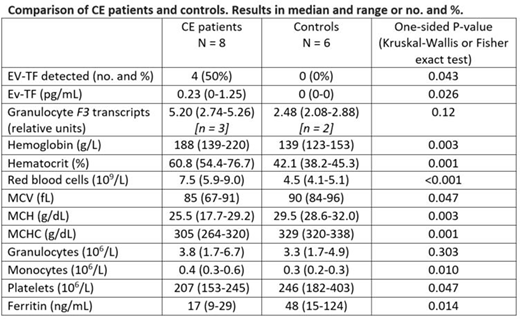Background:Chuvash erythrocytosis (CE), an inherited autosomal recessive disease endemic to Russia's mid-Volga River region, is caused by a germlineVHLC598T mutation (encoding VHLR200W) that alters oxygen sensing (PMID: 12415268). VHLR200W protein displays impaired degradation of hypoxia inducible transcription factor (HIF)-α subunits leading to increased HIF-1 and HIF-2 in normoxia and increased transcription of many HIF-regulated genes including erythropoietin (PMID: 14726398). CE patients have increased risk of venous and arterial thromboses, which are the major cause of morbidity and mortality (PMID:28104701). Thrombosis occurs despite lower blood pressure, body mass index and white blood cells compared to controls and is not related to the elevation in hematocrit but is increased in patients treated with phlebotomy therapy (PMID: 31289208). We have shown by microarray analysis of CE peripheral blood mononuclear cells modestly increased expression of several HIF-regulated pro-thrombotic genes at false discovery rate <0.05, includingIL1B(encoding interleukin-1beta),THBS1(thrombospondin-1),EGR1(early growth response 1),NLRP3,ITGA2B(integrin alpha-IIb),SERPINE1(plasminogen activator inhibitor-1) andF3(tissue factor) (PMID: 23993337). TF is a primary initiator of coagulation that binds factor VII/VIIa. The TF/factor VIIa complex catalyzes the conversion of inactive protease factor X to active protease factor Xa, leading to thrombin and thrombus formation (PMID: 19923557). EV-TF is barely detectable under basal circumstances but in disease states such as cardiovascular disease, sickle cell disease and cancer it derives from monocytes, endothelial cells, vascular smooth muscle cells and tumor cells (PMIDs: 20690821, 12805058, 17166244, 14988149, 26916302). Granulocytes of patients with polycythemia vera and essential thrombocytopenia expressF3as assessed by RT-qPCR (PMID: 32203583). Because of the central role of tissue factor in initiating the extrinsic pathway of coagulation, we set up to determine if extracellular vesicle associated tissue factor activity (EV-TF) could be detected in the plasma of CE patients.
Methods:EightVHLC598T homozygotes and 6VHLwild type controls from Cheboksary, Chuvashia, Russia were studied as outpatients under basal circumstances. Blood was collected from these participants by venipuncture into vacutainer tubes containing 0.129 M sodium citrate. Immediately after venipuncture, platelet free plasma (PFP) was prepared by two rounds of centrifugation at 2,500 × g for 15 minutes at room temperature and EVs were isolated from PFP by centrifugation at 20,000 g for 15 minutes at 4 ºC. EV-TF was measured in duplicate by a two-stage Factor Xa generation assay with and without anti-TF antibody using Innovin (Siemens Healthcare Diagnostics) as a standard (PMID: 30656275). We also isolated granulocyte mRNA from 3 of the patients and 2 of the controls at a different time point and measured F3 transcripts by RT-qPCR.
Results:We detected EV-TF in 4 of 8 CE patients but in no wild type controls (one-sided P = 0.043). The range of 0.45 to 1.25 pg/ml is similar to the range recently reported in US patients with cancer (PMID: 32548563). MCHC tended to be lower among 4 CE patients with detectable EV-TF than 4 without (one-sided P = 0.12), but this was not the case for serum ferritin. We also detectedF3transcripts in granulocytes, and these levels were higher in the 3 patients than the 2 controls that we analyzed (one-sided P = 0.12). Furthermore,F3mRNA correlated with plasma EV-TF in these five subjects (Spearman rho = 0.71, one-sided P < 0.05). As previously reported, CE patients had higher hemoglobin, hematocrit and red blood cells and lower platelets compared to controls (PMID: 14726398). They also had lower values for serum ferritin and mean corpuscular hemoglobin concentration (MCHC) suggesting iron deficiency, likely induced by phlebotomy therapy or by the presence of gastritis, which is increased in CE.
Discussion:The presence of EV-TF in the plasma of 4 out of 8 CE patients and none of six controls, and increasedF3transcripts in CE granulocytes, may point to a potential thrombogenic role, although none of the CE patients in this study had a history of thrombosis. Further studies on larger numbers of patients are warranted to confirm these findings and to clarify the potential role of EV-TF in thrombosis in CE.
*NM, JTP & VRG contributed equally
Gordeuk:CSL Behring:Consultancy, Research Funding;Ironwood:Research Funding;Imara:Research Funding;Global Blood Therapeutics:Consultancy, Research Funding;Novartis:Consultancy.
Author notes
Asterisk with author names denotes non-ASH members.


This feature is available to Subscribers Only
Sign In or Create an Account Close Modal